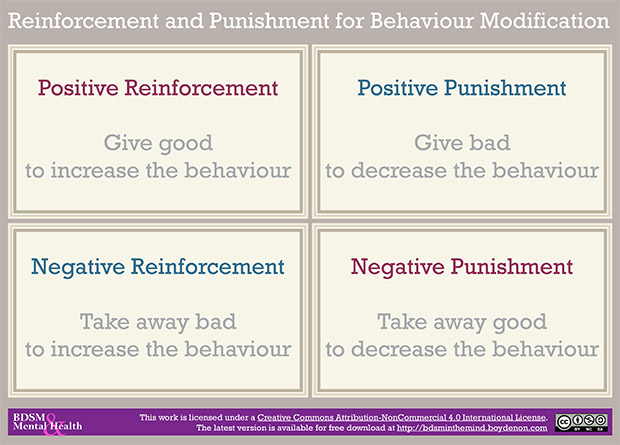Some degree of behaviour modification is part of nearly every Dominant/submissive or Master/slave relationship. The sub pleases the Dom by bending to some degree to their will. Unless there’s an absolutely perfect fit at the beginning of the relationship, there will be some degree of what we’d affectionately call “training”.
There are really only two ways of changing someone’s behaviour. The carrot and the stick.
Some Doms err on the side of the stick, saying that they will punish bad behaviour, but “good behaviour is expected, so why reward it?” or that the reward is intrinsic, because the Dom is happy. By doing the chores, for example, the sub pleases the Dom and good things happen in the household. Obedience as its own reward.
Some subs also prefer the stick, saying that “the physical act of punishment is a heavy reminder of why Master is Master, as well as an association that pain comes if i do not do as I’m told”. The punishment becomes symbolic of the power exchange bond, and often the logic is that without punishment, the sub does not really know when they have done something to displease the Dom, and so the rules and guidelines become more unclear and possibly confusing.
Many other Doms and subs (and most business management books) err on the side of the carrot. They feel that punishment is often used as an alternative to communicating properly if it is used without a clear explanation of what the Dom wants and how to achieve it and feedback that requirement is actually understood (and within the sub’s abilities). Many feel that the carrot, in the form of physical rewards (treats) or mental rewards (such as praise and attention), is far more powerful than the stick (punishment).
Regardless of which side of the fence you sit on in this debate, most Dominants use both positive and negative means to achieve their behaviour modification goals.
It’s important to understand that there are not two, but four different tools available for behaviour modification. Understanding the terms and being conscious of the methods you are using (and why) will make behaviour modification far more effective.
An A4 PDF of the above illustration is available for download here.
POSITIVE REINFORCEMENT
This is what most people think of when they think of “reward”. In exchange for behaviour that I want, I give you something tangible and physical, like a treat or a kiss, or something more psychological, like praise, a smile or attention.
NEGATIVE REINFORCEMENT
Because you’ve been a good boy, I’m going to remove that restriction you have on playing video games.
I’ve been annoyed with you for not cleaning my leather, but you spend an hour polishing it and I’m happy.
When you don’t bring my coffee fast enough, I get angry, but when you do bring it quickly I don’t get angry.
These are all examples of negative reinforcement. To avoid something unpleasant or to take away the bad thing, there is a behaviour that can be learned.
POSITIVE PUNISHMENT
This is what most people think of when they think of “punishment”. Because you behaved badly, you get a spanking, corner time, lines to write in a book or a period in your chastity cage. If I embarrass you in front of your friends because of something you did, that would be positive punishment.
NEGATIVE PUNISHMENT
Negative punishment removes something that you enjoy because of your undesirable behaviour. It could be physical, if I take your toy, game or privileges away, or it could be more psychological if I have been happy and warm to you but withdraw my affection and become cold and angry.
SOME IMPORTANT THINGS TO KNOW ABOUT REINFORCEMENT AND PUNISHMENT
Negative reinforcement is not necessarily the opposite of positive reinforcement, and negative punishment is not necessarily the opposite of positive punishment.
For example, if I praise you for doing a great job, that is positive reinforcement. But if I become sullen and withdrawn because you are not doing a great job, that is negative punishment (not negative reinforcement).
One reason why it is important to be conscious of the methods you are using is that all four can work in negative ways if applied incorrectly.
For example, if a boy becomes a brat because he isn’t getting what he wants, and a Dom gives into that, it is positive reinforcement. The lesson taught is “by becoming a brat i am rewarded”.
If a boy becomes a brat because he has to do a chore, and the Dom gives into that, it is negative reinforcement. There is a perceived negative situation, an action, and the action makes the negative go away. The lesson taught is “by becoming a brat I can improve my situation” and so becoming a brat is negatively reinforced.
OPERANT CONDITIONING AND MENTAL HEALTH
Mental health issues can cause some methods of behaviour modification to trigger in some circumstances. This is probably more so with positive and negative punishment than it is for positive and negative reinforcement, but all methods run risks.
BPD suffers, for example, will be particularly sensitive to negative punishment such as withdrawing affection. Or, some forms of positive punishment could trigger PTSD.
As with anything (whether or not mental health issues are involved), start slow, pay attention to verbal and non-verbal reactions and keep the communication lines open. You might be a Dom, but being unapproachable will always work to your disadvantage.
FURTHER READING
• North Shore Pediatric Therapy – The Difference Between Positive and Negative Punishment
• Educate Autism – 10 Examples of Negative Reinforcement
• AllPsych – Reinforcement and Reinforcement Schedules
• Kristin H Ricko – Skinner’s Theory of Operant Conditioning As Seen Through Positive Behavior Support
• Reference for Business – Reinforcement Theory
• B.E.S.T. Slave Training – Consequences of Bad Behaviour
• FetLife – Behaviour Modification


2 Comments Add yours